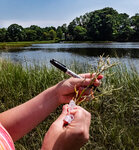


Salicornia (a.k.a. “sea bean,” “pickleweed,” or “glasswort”) is a common fixture in New England salt marshes. Many know it’s a favorite of foragers because it’s technically edible. Fewer people know that in the Middle Ages, Salicornia was burned for its fixed salt, and used in glass making thereby earning one of its nicknames.
Well, Salicornia is also a mighty fighter in the nature’s ecosystem, and last week, researchers from UMASS Boston came to Manchester to collect samples along the shore at Masconomo Park.
Alice Palmer is leading up the project, and with her colleague Cameron Gray they harvested some 30 samples of Salicornia. The plant is small, and highly salt-tolerant. It’s also a plant that sequesters heavy metals, so it has potential to mitigate pollution, but it hasn’t been extensively researched. This project hopes to offer data, and some clear answers.
Palmer’s study will catalog the Salicornia population’s genetics and ecology and survey the diversity of populations along the New England coast from Rye, New Hampshire to Cape Cod. By the time they are done, they hope to collect approximately 1,000 samples.
The research begs the question, “Given that sea beans or pickleweed are sponges for pollution, are these plants safe to eat?”
Palmer says, yes, if you know where they’ve been. If not, give them a pass.